In 1975, watching a movie in the theatre was a big deal for Mr. Gupta. There was the cumbersome process of finding the show timings, waiting in the long queue for the tickets, and yet face the risk of seeing the ‘Housefull’ board when his turn came. In 2010, Sandeep, his son, surfs the web, visits the online booking site, finds different movies, checks their reviews, checks shows timings available, books the tickets online through his card and reaches the multiplex just in time for the movie!!
This is the power of Information Technology (IT) which enables two-way communication between consumers and the enterprise. Improved IT infrastructure like ATMs and online payments have done away with the hassles of carrying big chunks of cash in your pocket while travelling
So, what exactly does IT cover? Anything involved with software, computers, networks, intranets, Web sites, servers, databases and telecommunications falls under the IT umbrella. IT is the technology that helps companies store, process and flow data within an organization. This sector ultimately serves other sectors like Banking, Manufacturing, Telecom, Hotels, Hospitals etc. to improve their efficiency and increase their revenues via customer satisfaction.
The Information Technology sector can broadly be classified into:
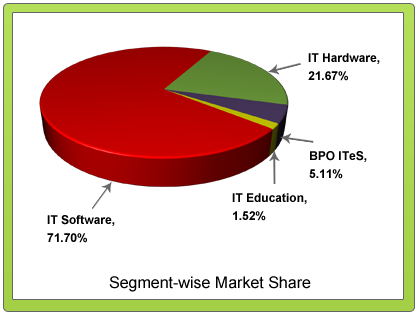 1. IT- Software – These companies help in developing and implementation of different software for their clients worldwide. These software could be for documentation, security services, banking softwares etc.
1. IT- Software – These companies help in developing and implementation of different software for their clients worldwide. These software could be for documentation, security services, banking softwares etc.
2. ITeS Business process outsourcing (BPO) – Major Corporations across the world outsource their back-office operations to some companies. E.g. Employee payroll for a US company’s global workforce is maintained by an Indian BPO. Slowly the definition is expanding to Human resources, accounting, logistics, legal processes etc.
3. IT- Hardware and peripherals – The stuff you can actually see and touch, and would likely break if you threw it out a fifth-story window, is hardware. This would include laptops, desktops, Storage devices, Networking devices, LCD, printers etc.
4. IT- Education This segment provides training for employment in the other segments. This would include companies providing various certification courses, like Java, Oracle etc. These companies also provide training for employees in corporate sector. Recently, some companies have also expanded this service to cater to schools and colleges.
This sector has made significant contributions to India’s economic growth in terms of GDP increase, foreign exchange earnings as well as employment generation. Its contribution to GDP has increased tenfold in last decade, from 0.6% to 6% till 2009-10. The sector has helped India transform from a rural and agriculture-based economy to a knowledge-based economy. Besides this, the lives of people have been positively influenced by direct or indirect contribution of IT sector to various parameters such as employment, standard of living, per-capita income etc.
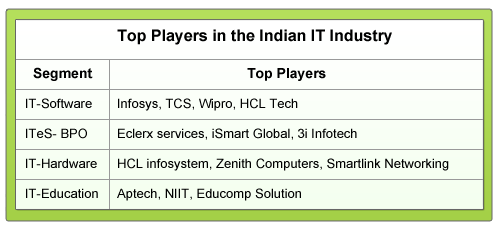
So, how does the sector work? Here’s the analysis…
In India, the IT Software segment has seen significant growth and has put India on the global map. It contributes for almost 75% of the total revenues of the IT sector. Though Hardware enjoys second place in terms of market share in India, it is quite low as compared to global benchmark. The BPO segment has grown well and is expected to make a footprint in the IT Sector.
Functioning of Software segment is explained pictorially in the figure below:
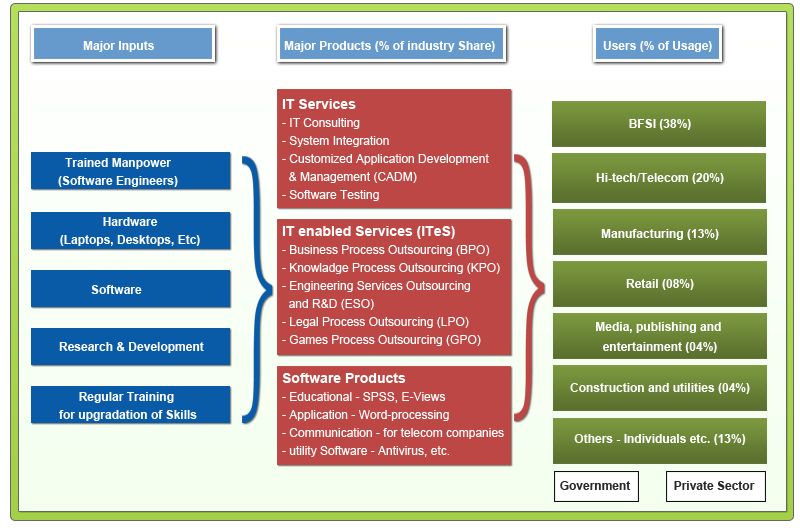
The software sector is service-oriented and thus the products offered are tailored to the requirement of its client. Hence, major input costs are those of human resources (forming almost 40% of the total costs) and research and development. Companies understand the requirements of clients and the product is developed accordingly.
What does the Past Say? Here’s the review of the Indian IT Sector….
In the last ten years the IT sector in India has grown at an average annual rate of 28%. India has emerged as the preferred destination for IT services owing to the cost advantage and talent pool.
India accounts for almost 51% of the global sourcing market. Exports contribute around 75% of the total revenue of the IT sector in India. However due to increased export-orientation and lesser domestic consumption the sector suffered major hit in the recession that shook the globe in 2008-09. In the year 2010, different economies began seeing recovery, but at varying pace. Indian companies have subsequently begun tapping other geographical markets and domestic consumption has also relatively increased.
Let’s see how each of the segments of the IT sector have fared in the past.

Comparing the Top Players
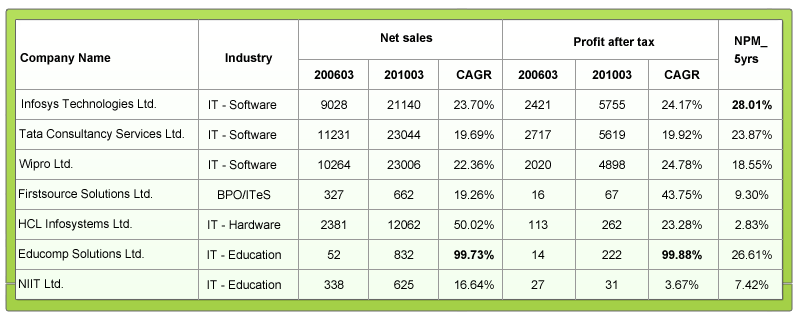
As can be seen from the table above, Educomp Solutions has clocked the highest Sales CAGR of 99% in the past five years, followed by HCL Infosystems (50%), Infosys (24%) and Wipro (22%). However, the highest margins are enjoyed by the software majors Infosys (28%), closely followed by Educomp (27%) and TCS (24%).
Porter’s 5 Forces analysis
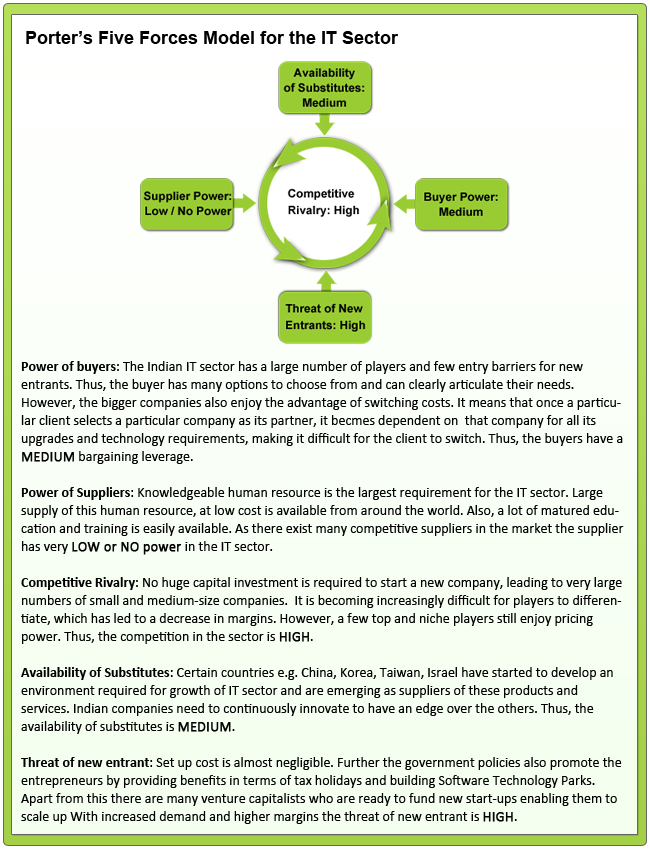
What are the growth drivers of the IT sector? Here’s the sector analysis…
1. Easy availability of Talent pool and cost advantage – The sector is human power and knowledge-oriented and this cost accounts for more than 40% of overall cost. Indians are considered to have better mathematical skills required for writing software. The easy availability of this talent pool makes it a long-term advantage. Widespread knowledge of English makes this pool employable, as compared to other countries like China, Japan etc. Also, it is 5 to 8 times cheaper to employ an Indian technologist than one from developed countries and thus the business has been flowing to India over the years.
2. Process and Quality – Nearly all the Indian software companies take CMM (Capability Maturity Model) certification, which is the benchmark of quality management. Out of approximately 250 companies reaching supreme level i.e. level 5 of CMM, 60 are from India. This gives the impression of the company being dependable and hence, helps them tap the market easily.
3. Supportive government policies – In early 1970’s when Americans began looking offshore for software development, the government policies of India were not much supportive. However, post liberalisation the government recognised the potential and took supportive stance towards IT by reducing import tariff on Hardware and Software, developing Software Technology Parks and introducing legislative actions to protect intellectual property (e.g. Information technology act 2000). Indian government policies are framed in a way that ensures maximum benefit out of IT outsourcing to India.
4. Unique geographic location – The major consumer of IT products so far has been the US. The time difference between India and US is 12 hours and it offers “economy of 24 hours a day” by communication equipment.
So, is there anything to be concerned about?
1. Threat of new emerging service economies – Along with India, Israel and Ireland carry most of the benefits for development of IT Sector. These countries are now taking up the market share and posing threat to Indian IT sector. Moreover, software sector of Korea, Taiwan, Philippine challenges India.
2. Emergence of China as substitute – China is gradually emerging as a tough competitor in offshore IT services. China has begun offering better rates with reduced operational costs as compared to India, because of its low cost talent pool. The government of China is taking measures to improve the IT sector and to overcome the language barrier.
Although China has not yet reached India’s revenue rate of USD 12.7 billion/year from Information technology services, China’s IT and BPO sector is expected to grow 30 percent annually by 2013. Bill Gates has forecasted that software sector of China would reach India’s in 5 years.
3. Hardware Sector lagging behind – India is the leader for Software and ITeS sector. However, the development of hardware sector has been lagging, due to it being a low margin business. Indian companies thus have to depend on foreign countries for their hardware requirement.
4. Poor Infrastructure – Greater communication facilities are necessary for software, ITeS, BPO to grow at faster rate. Communication network in India is far behind most of the western developed countries and worse than our closest competitor China. Arrival of 3G however, will give a relief to some extent.
5. Concentrated market and Anti-outsourcing – United States and United Kingdom have been the dominant market for Indian IT sector. This dependency and concentration on few markets resulted in sudden fall in demand towards the end of last decade on the aftermath of the recent global crisis. Also, countries have started raising their concerns regarding migration of jobs to India. Diversified client base would help reduce the dependency of the sector on few economies.
6. Domestic consumption – Overseas market accounts for 75% of Indian software sector, mainly from software outsourcing. The demand for IT products within India has been very less, as compared to those by other countries. The environment necessary for further growth of software sector would come with domestic consumption of its products.
7. Exchange rate – A major part of the Sector revenue is earned in Foreign currency (due to high exports) but it incurs expenses (e.g. employee salary) in Indian rupees. Thus, appreciation of rupee reduces revenues whereas depreciation increases the revenues. The fluctuating exchange rate brings volatility in operating margins for IT sector.
What is the future outlook for this IT Sector in India?
After recession, the year 2010 has seen steady recovery by the sector. Global markets have seen a growth of 5% in GDP, with developing nations growing faster than developed nations. IT spend in 2011 is expected to grow nearly 4%. Worldwide IT spending will also benefit from the accelerated recovery in emerging market.
According to NASSCOM, India can reach $ 130 Billion in IT revenue by 2015, with CAGR of 14%. With this, it would be contributing to 7% of annual GDP and creating 14.3 million employment opportunities.
With the government taking active measures to stimulate the growth of IT sector and emergence of BPO and KPO over last few years, India is expected to climb the global value and knowledge chain. In long-term we can expect the Indian IT sector to see good growth. Different segments of the sector are set to experience different growth rates. BPO industry will experience high growth but the Software and ITeS segment is expected to see slower growth.
However, on company basis each company has to compete against other domestic as well as global player. They have to adapt new business models to compete with global players e.g. Cloud, On-demand services, and SaaS. With increased threat from countries like China, the companies will suffer loss unless they change business models.
It is very important that while investing in a company, an investor selects a sector, where the long-term future prospects are bright. In the above case, we have seen that the IT sector is expected to have good growth in the long run. Also, it is equally important that the company has an excellent financial track record( i.e. Green 10 Year X-Ray) and its long-term future prospects are Green (Very Good).
*The 10 YEAR X-RAY facilitates analysis of the financial performance of the company considering the five most important parameters. A 10 Year period will normally encompass an entire business cycle. Analysing the performance over this time frame is essential to understand how a company has fared during the good as well as bad times. The five most important parameters that one needs to look at are Net Sales Growth Rate, EPS Growth Rate, Book Value Per Share (BVPS) Growth Rate, Return on Invested Capital (ROIC) and Debt to Net Profit Ratio.
Given below is the MoneyWorks4me assessment for a few IT companies: At MoneyWorks4me we have assigned colour codes to the 10 YEAR X-RAY and Future Prospects of the companies, as Green (Very Good), Orange (‘Somewhat Good’) and Red (Not Good).
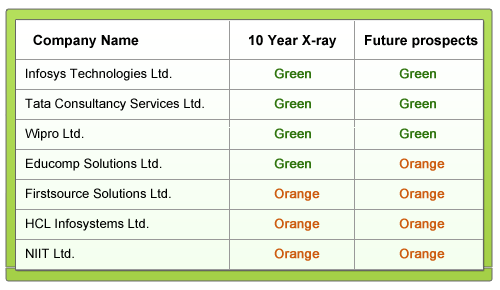
While investing, one must always invest in a company that operates in a sector with bright long-term prospects. Further, the company’s 10 YEAR X-RAY and future prospects should also be Green. The table above gives you a list of few Indian companies from the IT Sector that you could consider investing in. But, you need to invest in these companies at the right price (i.e. when the market offers an attractive discount). To find out the right price to invest in these companies, become a member of MoneyWorks4me.com.
Disclaimer: This publication has been prepared solely for information purpose and does not constitute a solicitation to any person to buy or sell a security. It does not constitute a personal recommendation or take into account the particular investment objectives, financial situations or needs of an individual client or a corporate/s or any entity/ies. The person should use his/her own judgment while taking investment decisions.
If you liked what you read and would like to put it in to practice Register at MoneyWorks4me.com. You will get amazing FREE features that will enable you to invest in Stocks and Mutual Funds the right way.
Need help on Investing? And more….Puchho Befikar
Kyunki yeh paise ka mamala hai
Start Chat | Request a Callback | Call 020 6725 8333 | WhatsApp 8055769463




Your sector coverage has been simply superb…… No non-sense page filling… right core of the fact need to be aware by retail investor…..kudos to the team 🙂
It is great to know that you have liked our analysis. Thanks a lot for the appreciation. Do keep reading and posting your feedback.
I am like a gramaphone record repeating time and again but…great analysis once again!
Some observations:
Though all IT companies are analyzed at a high level here, the risks are probably different in each sub-category of IT company. For example: Software companies like Infy and TCS compete at a global level with giants like IBM, Headstrong, Accenture etc in various industries and also requiring different skill sets compared to a small 10 man software company in Bangalore or Gurgaon.
Education companies like Educomp or Everonn derive most of their revenues from the education sector and so it would not be appropriate to call them IT companies and that is one short fall on the BSE or NSE as well. Therefore it is not appropriate to compare their risks with Infy or TCS. Instead, the fortunes of Educomp or Everonn is tied to the education industry where their less cyclicality of revenue but more tied to the state and central budgets and policies. Also, their target audience/ consumers are schools or Govt’s and not other IT companies or fortune 2000 companies. The competition too is more local than global as the market is local. There is very little competition from global players currently.
Similarly, hardware companies like HCL or Wipro could probably compared with respective product lines like Dell or HP and with software companies for their software business revenues.
One of the key risks that has been not analyzed by you is the bargaining power of employees. As you have rightly recognized, IT is a knowledge intensive industry and so highly capable employees can and do hold their bosses to ransom. If their employer refuses higher salary, bonus or title, or even opportunity to work on interesting projects, they just walk out the door and to a competitor who can offer them the same. Just attending a computer course from Aptech or NIIT, or being a computer graduate (mostly taught outdated technology) is not the criteria for getting a job – real hands on experience is what is required to make it in the industry. So availability of cheap labor is there but without much quality, while quality labour demands higher compensation driving down the operating margin.
(Regarding infrastructure risk, somethings to consider are uninterrupted power supply, speedy access to offices and airports etc., also affect the industry as many small companies cannot afford to run for long hours on generators or UPS. People spend a lot of time commuting and get stressed out because of it and are less productive.)
Hi,
You seem to be an ardent reader of our blogs and we are glad that you have been liking our analysis so much.
Yes, we completely agree with you that sub-segments of the IT sector are not comparable with each other. There is no way you can compare an Infosys with Educomp Solutions as their business models are completely different. And rightly analysed by you, Educomp and Everonn are 2 major players that operate in the K-12 education segment; their revenues are more driven by how the Government policies work with respect to the education sector, especially Government schools and colleges.
Also, as you mentioned, quality is more important than quantity. There is no point in the abundance of cheap labor if a certain minimum level of quality is not there.
Do keep reading our blogs. Your feedback has always helped us improve our analysis.
Thanks a lot for the appreciation. Do keep reading and posting your feedback.
tcs,infosys,wipro and educomp though company futrure prospects are very good.
Excellent analysis —Team
really nice information
excellent an comprehensive article. finally i now understand what exactly apart from software and hardware form a part of IT sector. superb!
however can you pls indicate the year in which the blog was written. i’d like to use some of the information for my research work. i need to acknowledge the same.
Hello,
Thank you for such an insightful article. I am doing some academic work on this and would appreciate if you could provide me with references please.
Regards
This site was… how do you say it? Relevant!! Finally
I’ve found something which helped me. Thank you!